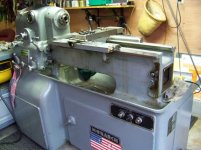10EE Leadscrew, Feed-Rod and Apron Removal - DRAFT
This is part of a procedure that Dave and I have been collaborating on. I've edited out most of the round-dial related stuff. At some point we'll post the full carriage and apron removal procedure. Dave will need to add corrections and comments. If anyone else can help with this, please do so.
The most difficult part about removing the apron is getting the leadscrew, feed-rod and leadscrew reverse control rod (if present) disconnected. Beyond that, the apron is removed by unbolted and lowering it.
Dave has provided me with a series of photos showing the process of removing the apron on his machine, which has electric leadscrews reverse (ELSR). I uploaded the photos to photobucket. Here is a link to the album:
The photos are fairly self explanatory. The titles and descriptions should provide additional information. Hover your mouse over the thumbnails in the album to see the titles. Open the photos to see the descriptions.
The procedure for both round- and square-dial machines is
basically the same—however, the differences in how the leadscrew, etc., are attached at the gearbox preclude a single, detailed procedure. Below are the basic steps for a square-dial, with discussion of some of the differences.
- Remove the socket head cap screws (SHCSs) that hold the leadscrew/feed-rod right bearing support casting. On square-dial machines with ELSR, disconnect the wiring. (Dave?)
- Remove the taper pin from the left end of the leadscrew (see Notes on removing taper pins, below).
- Disconnect the feed-rod.
Note: 10EEs were available with and without safety disconnect clutches on the left end of the feed-rod. If there is no clutch, disconnecting the feed-rod is simply a matter of removing a tapered pin. Some clutches had plates with 3 screws that hold the two halves of the clutch together; in that case it is simply a matter of removing the screws so that the halves can separate.
- Use the carriage to jack the leadscrew and feed-rod free: Move the carriage until one of the lines on the thread dial lines up with the index and close the half-nut. If you have a feed-rod clutch, the feed rod should already be free. If not, you may want to install a two-piece shaft collar or soft-jawed clamp on the feed-rod, against the right side of the apron. Now use the apron feed hand-wheel to move the carriage to the right until the ends of the leadscrew and feed rod are free. On square-dial ELSR machines make sure that you don’t damage the wiring in the right support housing.
- Remove the leadscrew and bearing-support as a unit. The feed-rod should unplug from the right bearing with ease.
- Prepare a support for the apron: Move the carriage all the way to the right and place a 2x6 across the chip pan (you want to block up the rear of the 2x6 to be level so the apron can sit there safely):
IMG_2493
IMG_2490
- Remove the SHCSs connecting the saddle to the apron by lowering it using some of the screws. I replace 4 of the screws with longer SHCSs (or lengths of all thread with nuts) and washers, as shown in the photo below. I then back the remaining screws out until they are only engaged 3 turns or so and then back the 4 long screws out in sequence to lower the apron. Repeat as required using longer bolts until the apron is resting on the supporting 2x6.
IMG_2493
Notes on removing taper pins
Monarch used a lot of taper pins to secure knobs to shafts and to pin shafts together. These pins were typically installed during assembly and were hand drilled and reamed on the machine. As a result, the pins are usually off center and at funny angles. Taper-pinned parts are usually not interchangeable without modification.
The fact that the pins were installed on the machine sometimes means that they are difficult to remove since the small end of the pin can sometimes be in a difficult place to access. Any time you find a situation where only one end of a pin is easily accessible, such as the knobs on the round-dial gearbox, expect that the large end of the pin is on the easily accessed side.
It’s critical to identify the small end of a tapered pin before attempting to drive it out; it’s a very good idea to not rely on your eyes and to measure the ends of the pin to verify which end is the small end. Some pins will drive out easily with a punch and a few well placed blows. Often the pins are driven in so tightly that they are difficult to drive out with a punch. In these situations it’s better to press the pin out.
One of my favorite methods of pressing out a tapered pin is to use a bearing ball (BB), a washer, a machinist’s parallel clamp and some hot-glue to make a simple press. I hot-glue the washer to the side of the shaft with the large end of the taper pin (see
IMG_2498); a 0.200” spacer from a round space block set works well as a washer. I hot-glue the BB to the tip of the parallel clamp (see
IMG_2499c). The clamp and BB are then lined up on the small end of the taper pin and the opposing washer (see
IMG_2500c) and the clamp is tightened to press on the pin and loosen it.
Cal










